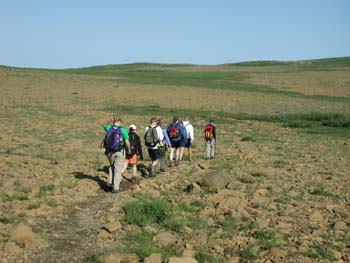 |
What We Saw of Geologic Importance
The beginning of our hike lead us through a flat plain of dusty brown rocks.
Though insignificant in appearance, these rocks actually have a great deal
of geologic importance! They are from the "center of the Earth," or, more
specifically, the Earth's mantle, and are discussed in further detail at
the Tablelands site.
At the hightest elevation on the trail, large granite-like masses composed
mainly of quartz, plagioclase feldspar and mica were revealed. Because
the rocks don't contain any potassium feldspar, they are called plagiogranites,
which represent a part of the ophiolite complex. These rocks, unlike the
first dusty-brown rocks we saw, can support life because they are high
in important life-giving elements such as calcium, sodium, and aluminum.
For this reason, this mountaineous part of our hike exhibited plenty of
trees, shrubbery and other small plants, as well as small ground animals,
birds, and the rare moose. Though we constantly scanned the ground below
us, we didn't see any moose!
After hiking some more, we finally reached the coast. There, we observed
wave refraction, including an interesting case of almost circular refraction;
the cliffs and numerous
sea stacks; diverse rocky beaches; and the magnificent displays of the
ophiolite complex. |